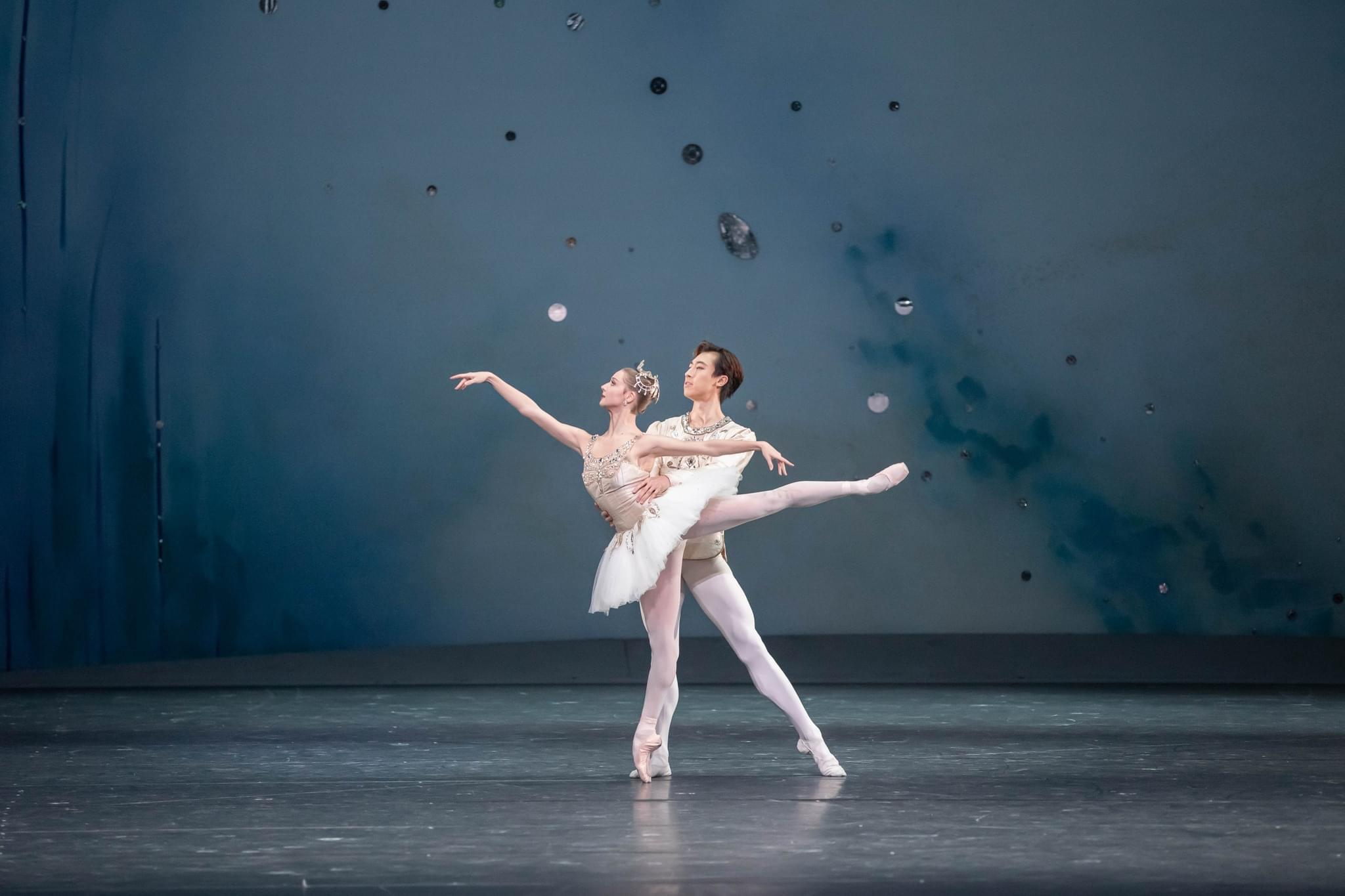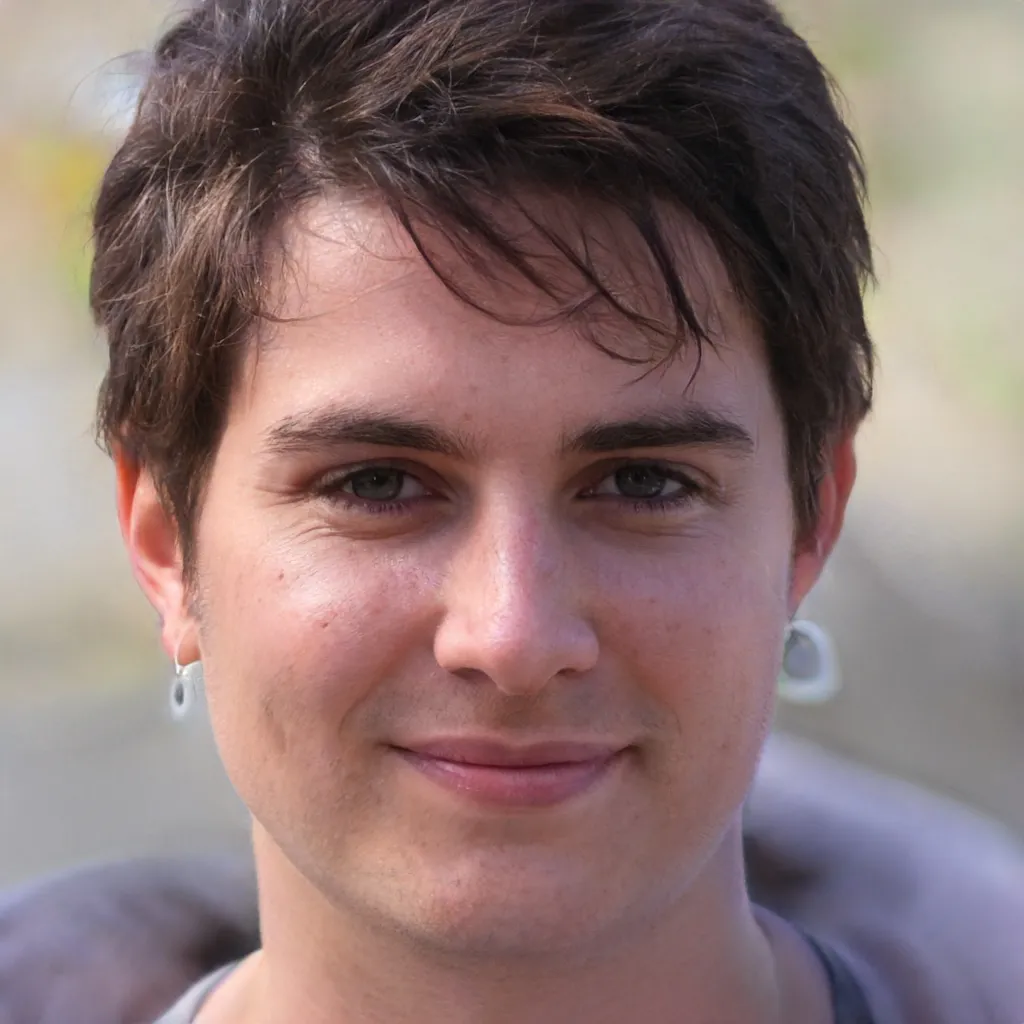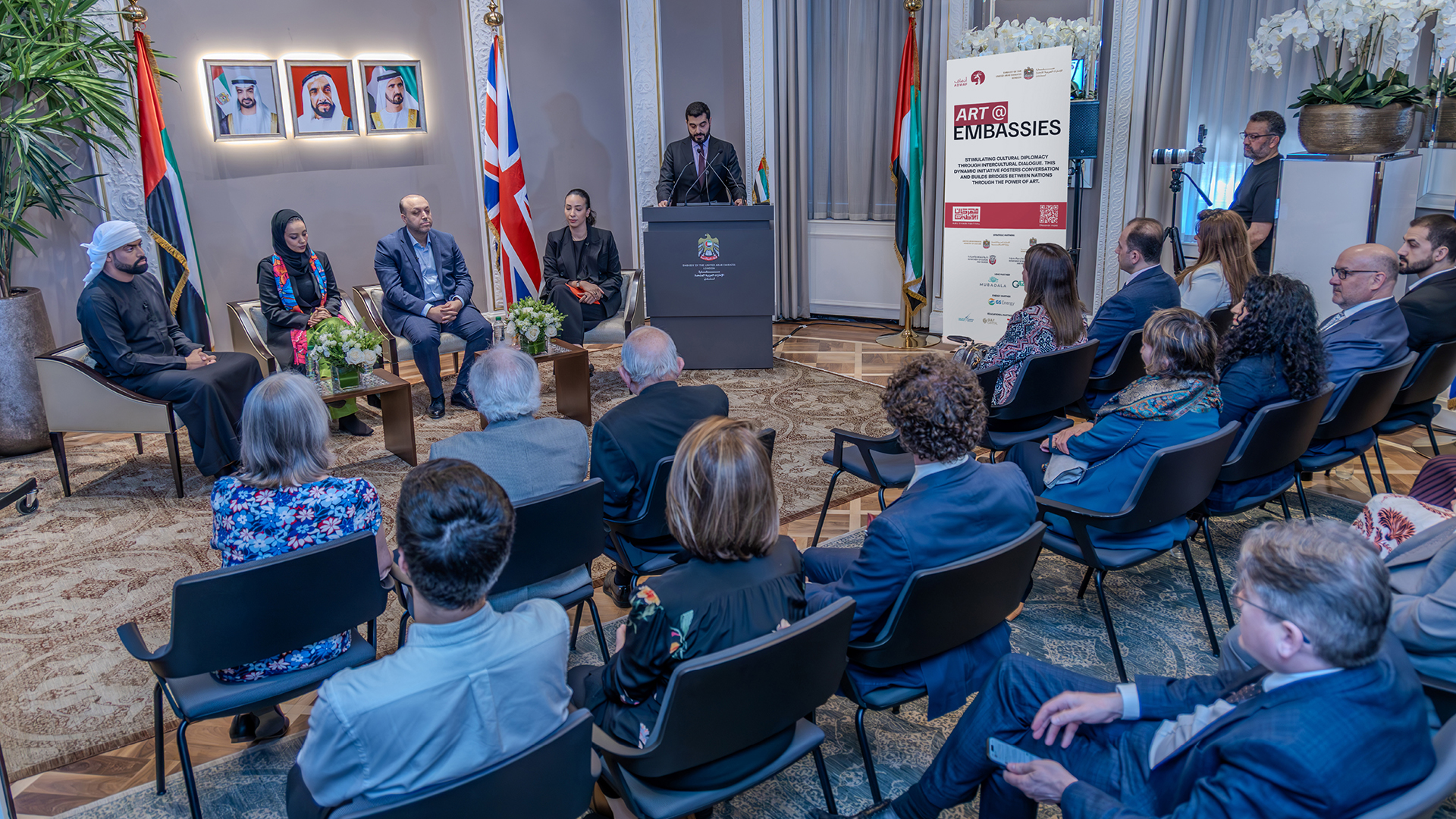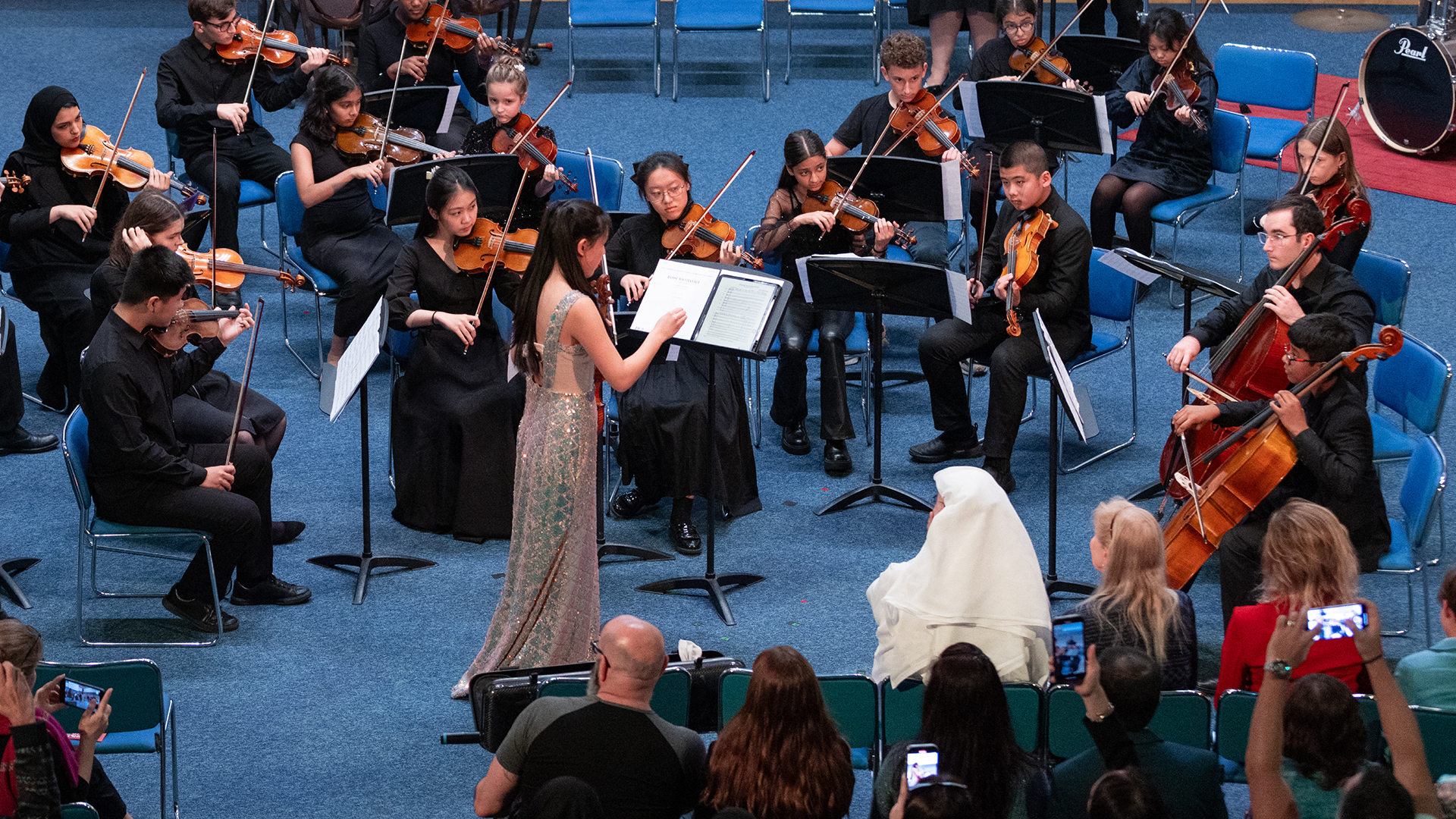Overview
Abu Dhabi Festival presents a dazzling ballet gala featuring the world’s most celebrated dancers. Representing prestigious ballet companies from around the world, including the Royal Ballet, Bayerisches Staatsballett, and Stuttgart Ballet, these exceptional artists will captivate audiences with their artistry and technical brilliance. The program covers a stunning mix of iconic classical repertoire and contemporary masterpieces. Highlights include performances by Jinhao Zhang and Madison Young of Bayerisches Staatsballett (both Prix de Lausanne winners), Stuttgart Ballet’s Principal Dancers Martí Paixà and Elisa Badenes (Youth America Grand Prix), and, from the Royal Ballet, Principal Dancer Ryoichi Hirano (Prix de Lausanne) and First Soloist Melissa Hamilton (Youth America Grand Prix). A star-studded night to remember!
Programme
Spring Waters
Choreography: Asaf Messerer
Music: Sergei Rachmaninov
Spring Waters was created in 1959 by Asaf Messerer, choreographer and former soloist with the Bolshoi Ballet. It is a work for two dancers that conjures up the first days of spring, requiring agility, athleticism and buoyant energy.
Diamonds (from Jewels)
Choreography: George Balanchine
Music: Pyotr Ilyich Tchaikovsky, Symphony No. 3 in D major, op. 29
Jewels was first performed by members of the New York City Ballet in 1957. Balanchine was inspired by a visit to the jewellers, Van Cleef and Arpels, and created a three-movement ballet, each section inspired by a different jewel. Emeralds is danced to music by Fauré, Rubies to Stravinsky, while the final movement, Diamonds, draws on all the grandeur of Balanchine’s classical Russian heritage, to music by Tchaikovsky.
Cinderella Act Two pas de deux
Choreography: Christopher Wheeldon
Music: Sergei Prokofiev
Cinderella was left at home when her stepmother and two sisters went to the ball. Transformed by the spirits of Lightness, Fluidity, Generosity and Mystery she is taught the waltz steps that she needs to know and arrives at the ball in disguise. She dances with Prince Guillaume, who is entranced by this beautiful stranger – they fall deeply in love.
Nachtmerrie (Nightmare)
Choreography: Marco Goecke
Music: Lady Gaga, Keith Jarrett
Made for the Stuttgart Ballet in 2021 this work takes its title from the Dutch word for nightmare. Two dancers confront one another, their connection charged with tension and suppressed emotion. Their movements are highly charged, making shapes full of pain and anguish.
Giselle Act Two pas de deux
Choreography: Jean Coralli and Jules Perrot
Music: Adolphe Adam
Giselle, a young peasant girl, has fallen in love with Albrecht, who returns her love but who is a nobleman in disguise, already engaged to be married. When she discovers his real identity Giselle goes mad and dies of heartbreak. She is summoned from her grave by the Queen of the Willis, ghosts of women who have been betrayed in love and who, in revenge, dance their lovers to death from exhaustion. Giselle is obliged to dance with Albrecht, who comes to mourn at her grave, but her true love saves him from death.
Interval
Onegin Act One, Mirror pas de deux
Choreography: John Cranko
Music: Pyotr Ilyich Tchaikovsky
John Cranko became fascinated by Pushkin’s novel in verse, Eugene Onegin, when he choreographed the dance scenes for Tchaikovsky’s opera in 1952. He went on to create his own full-length ballet based on the work, for the Stuttgart Ballet, in 1965. Here, the youthful Tatyana has fallen headlong in love with Onegin, a man she hardly knows. She writes him a passionate letter and conjures him up in her dreams.
Swan Lake Black Swan pas de deux
Choreography: Marius Petipa and Lev Ivanov
Music: Pyotry Ilyich Tchaikovsky
Prince Siegfried has fallen in love with Odette, a beautiful young woman he has found in the forest while hunting. She has been turned into a swan by an evil sorcerer. The Prince swears to love her but is seduced by the treacherous Odile, who turns up at a grand ball in Odette’s place. This pas de deux is highly dramatic and technically challenging.
The Man I Love from Who Cares?
Choreography: George Balanchine
Music: George Gershwin
In 1970 Balanchine choreographed a ballet, Who Cares? to a selection of songs by George Gershwin that were orchestrated by Hershy Kay. One of the original cast members said ‘It’s so unlike Balanchine, it’s so jazzy … it’s sort of like a tap dance en pointe.’ Balanchine had fallen in love with Gershwin’s music after the composer gave him a book of his songs when they worked together on the film The Goldwyn Follies in 1938.
Don Quixote Act Three, Grand pas de deux
Choreography: Marius Petipa
Music: Ludwig Minkus
A dazzling showpiece for the two dancers in the roles of Kitri and Basilio, this has all the grandeur of the classical Russian style. Minkus was an Austrian composer and teacher who in 1871 took the official post of Composer of Ballet Music to the Imperial Theatres in St Petersburg, remaining in that capacity until his retirement in 1886. He composed many ballet scores, including La Bayadère (1877) and Don Quixote (1869), both with choreography by Petipa.
Artists
JINHAO ZHANG
Principal Ballet Dancer, Bayerisches Staatsballet
Born in 1995 in Dalian, China, and raised in Shanghai, Jinhao Zhang began his formal dance education at Tongji University, Shanghai. In 2009 danced and acted as a young student in Mao’s Last Dancer, an Australian film based on professional dancer Li Cunxin's 2003 autobiographical memoir of the same name. Zhang’s talent was recognized early: he won Silver Medal at the Genée International Ballet Competition (2011), won the Prix de Lausanne (2013), and claimed both the Silver Medal and the Best Choreography Award at the Beijing International Ballet and Choreography Competition (2015).
In 2013, he joined the English National Ballet School and, the following year, became a member of the English National Ballet. His potential was further acknowledged when he won the Emerging Dancer Award in 2015. Seeking new challenges, Zhang joined the Bayerisches Staatsballett in the 2017/18 season as Demi-Soloist. He quickly ascended the ranks, becoming a Soloist in 2018/19 and earning the prestigious title of Principal Dancer in the 2021/22 season.
Renowned for his versatility, Zhang’s repertoire includes iconic roles such as Albrecht in Giselle, Siegfried/Rothbart in Swan Lake, Onegin’s title role (John Cranko), Des Grieux in The Lady of the Camellias, and Romeo in Romeo and Juliet, and lead roles in Spartacus (Yuri Grigorovich), Anna Karenina (Christian Spuck), and A Midsummer Night's Dream (John Neumeier). He has also danced in contemporary pieces including Alexei Ratmansky's Pictures at an Exhibition, Russell Maliphant’s Broken Fall and collaborated with the choreographers to create Andrey Kaydanovskiy’s Cecil Hotel, Aszure Barton’s Fantastic Beings, Annabelle Ochoa’s Broken Wings, and Akram Khan’s Giselle.
MADISON YOUNG
Principal Dancer, Bayerisches Staatsballet
Madison Young was born in Utah, USA. She received her education at Ballet West Academy and Houston Ballet Academy in Texas. At the Prix de Lausanne in 2016, she received the Beau Rivage Palace Second Place Award and accepted an apprenticeship for Houston Ballet in the season 2016/17, where she was promoted to group dancer in 2017. In the 2017/18 season, she joined the Wiener Staatsballet as a Corps de Ballet dancer under the direction of Manuel Legris. In 2018, she was promoted to Soloist and in 2019, to First Soloist. At the beginning of the 2020-21, she joined the Bayerisches Staatsballet as First Soloist. In December 2021 she was promoted to Principal.
Young’s roles include Tatiana in Onegin (John Cranko), the title roles in La Sylphide (Pierre Lacotte), Giselle (Peter Wright), Cinderella (Christopher Wheeldon), and Alice's Adventures in Wonderland (Wheeldon). She has also performed Odette/Odile in Swan Lake (Ray Barra), Juliet in Romeo and Juliet (John Cranko), Miranda in Tchaikovsky Overtures (Alexei Ratmansky), and Hippolyta/Titania in A Midsummer Night's Dream (John Neumeier).
ELISA BADENES
Principal Dancer, Stuttgart Ballet
Elisa Badenes was born in Valencia, Spain. She attended the Conservatorio Profesional de Danza de Valencia. At the Prix de Lausanne in 2008 she won a scholarship for the Royal Ballet School from which she graduated one year later. In the 2009 she joined the Stuttgart Ballet and was promoted to Principal Dancer in 2013.
Her repertory includes a wide range of leading roles including Odette/Odile in Swan Lake, Juliet in Romeo and Juliet, Tatiana in Onegin and Katherina in The Taming of the Shrew (all by John Cranko), the title role in Giselle (after Jean Coralli, Jules Perrot, Marius Petipa), Lise in La fille mal gardée (Frederick Ashton), Kitri in Don Quixote (Maximiliano Guerra after Petipa), Aurora in The Sleeping Beauty (Marcia Haydée after Petipa), Marguerite Gautier in The Lady of the Camellias, Desdemona in Othello and Stella in A Streetcar named Desire (all John Neumeier), Mary Vetsera in Mayerling (Kenneth MacMillan), Effi in La Sylphide (Peter Schaufuss after August Bournonville) and the solo The Dying Swan (after Michel Fokine). In addition, she has danced solo roles in ballets by George Balanchine, John Cranko, Edward Clug, Jorma Elo, William Forsythe, Johan Inger, Jiří Kylián, Kenneth MacMillan, Hans van Manen and Jerome Robbins.
Choreographers such as Fabio Adorisio, Mauro Bigonzetti, Sidi Larbi Cherkaoui, David Dawson, Marco Goecke, Shaked Heller, Johan Inger, Katarzyna Kozielska, Douglas Lee, Wayne McGregor, Christian Spuck, Louis Stiens and Demis Volpi have created roles for her. In 2016 Demis Volpi created the title role in his Salome for her and in 2022 Edward Clug created the leading role of Clara in The Nutcracker for her.
Badenes has received several honors and prizes including the Gold medal of the Youth American Grand Prix, the Audience Choice Award of the Erik Bruhn Competition in Toronto in 2011 and the German Dance Prize Future in 2015. In 2023 she was awarded “Dancer of the Year” by the “Dance Europe” magazine.
In December 2023 she was awarded the national title of "Kammertänzerin".
MARTÍ PAIXÀ
Principal Dancer, Stuttgart Ballet
Born in Reus, Catalonia, Spain, Paixà attended a private ballet school in his hometown, before joining the John Cranko Schule in Stuttgart, from which he graduated in 2014. In the 2014/15 season he became an Apprentice with the Stuttgart Ballet and was soon taken into the Corps de Ballet. His career quickly rocketed: in 2016, he was promoted to Demi Soloist and the following year, to Soloist. He became a Principal Dancer at the beginning of the 2021/22 season.
Paixà successfully participated in various competitions: he won scholarships for the John Cranko School in Stuttgart and for the Heinz Bosl Foundation in Munich. He also took part in the Rosetta Mauri International Competition in May 2011. In June of the same year, he participated in the International Dance Competition of Ribarroja (Valencia), where he won second prize in the highest category.
Paixà is known for his technical brilliance, dramatic range and fantastic partnering skills and his signature roles include the lead in The Taming of the Shrew and Onegin (Cranko), Sleeping Beauty (Haydée), and Lady of the Camellias (Neumeier). Demis Volpi created the title role in The Soldier’s Tale especially for him.
This season Martí debuted as Romeo in Cranko’s version of the Shakespeare classic and was invited to participate in the prestigious Roberto Bolle and Friends Gala in Torino.
EMMA JANE HAWES
Lead Principal, English National Ballet
Born in Delaware, Emma Hawes began her training at BalletMet Dance Academy in Columbus, Ohio, and later at Canada’s National Ballet School.
She began her professional career at the National Ballet of Canada, and in 2018, she became a member of the English National Ballet, rapidly earning recognition for her remarkable technique and emotional expressivity. In 2022, she was promoted to Principal dancer, and by 2023, had earned the prestigious title of Lead Principal.
Hawes has gained recognition for performing the title roles in classics that include Giselle, Raymonda, Swan Lake, Manon and Cinderella, in Wheeldon’s version of the fairytale. She also originated the role of the Sugar Plum Fairy in Watkin and Smith’s Nutcracker. Hawes excels in contemporary works, performing in pieces like Possokhov’s Senseless Kindness, Dawson’s Four Last Songs, and Balanchine’s Theme and Variations.
Emma Hawes won the Audience Choice Award at the Erik Bruhn Prize Competition in 2012.
AITOR ARRIETA
Lead Principal, English National Ballet
Aitor Arrieta, born in Oiartzun, Spain, in the Basque Country, is a distinguished ballet dancer known for his versatility, technical brilliance, and compelling stage presence. He received the Gold Medal at the International Dance Contest of Biarritz in 2013 and first place at the Championship of Euskadi Aurresku in 2011. In 2017, he was named joint winner of the Emerging Dancer Award.
He received formal training at the Royal Conservatory of Dance Mariemma in Madrid, and began his professional career with the Compañía Nacional de Danza, where he quickly established himself as a promising talent. In 2016, he joined the English National Ballet, and in just one year, was promoted to Soloist. His career skyrocketed with a promotion to First Soloist in 2019, Principal Dancer, in 2022, and finally Lead Principal, in 2023.
Throughout his career, Aitor has been celebrated for his wide-ranging repertoire, performing both classical and contemporary roles with equal mastery. Notable performances include the main roles in Khan’s Giselle, Rojo’s Raymonda (Rojo), and Deane’s Swan Lake. He has contributed to the creation of several roles, including Sugar Plum Cavalier in Watkin and Smith’s Nutcracker and in Forsythe’s Playlist (Track 1, 2).
Arrieta’s technical prowess, emotional depth, and ability to bring diverse characters to life on stage has earned him a place as one of the most dynamic and exciting dancers of his generation.
MATHIEU GANIO
Étoile, Opéra National de Paris
Born in Marseille on March 16, 1984, Mathieu Ganio began his dance training at the age of 7, although he had already taken his first steps on stage at the age of 2 in Roland Petit’s ballet Ma Pavlova, alongside his parents, who were also dancers. He continued his education at the École nationale supérieure de Danse de Marseille from 1992 to 1999, then at the Paris Opera Ballet School from 1999 to 2000, after which he joined the Paris Opera Ballet at the age of 17. Each year, he climbs the ranks of the company following the annual promotion competition: Quadrille in 2001, Coryphée in 2002 and Sujet in 2003. On May 20, 2004, following the performance of Nureyev’s Don Quixote (in which he interpreted the role of Basilio), he was named Étoile, at the age of 20 and without passing through the class of 1er danseur.
Since then, he has performed most of the great roles of the classical repertoire, including Prince Désiré in Sleeping Beauty, Prince Siegfried in Swan Lake, James in La Sylphide, Drosselmeier in The Nutcracker, Albrecht in Giselle, Romeo in Romeo and Juliet and Onegin in John Cranko’s ballet of the same name. He has danced in ballets by George Balanchine, Jérôme Robbins, Kenneth MacMillan, Maurice Béjart, William Forsythe, Mats Ek, Jiri Kylian and others. He also dances in more contemporary productions and works and participates in creations with great choreographers such as John Neumeier, Pierre Lacotte, Roland Petit, José Martinez, Nicolas Leriche, Saburo Teshigawara, and Marco Goecke. He takes part in numerous tours abroad with the Paris Opera, but also performs regularly at international galas, notably in Japan, and has been invited to dance repertory ballets at the Mariinsky Theatre in St Petersburg on several occasions. In 2016, Orianne Moretti created Le Rappel des Oiseaux, a play based on Gogol’s Diary of a Madman.
He received the Benois de la Danse award in 2005 for his interpretation of James in Pierre Lacotte’s La Sylphide, and was named Officier des Arts et Lettres in 2020.
LÉONORE BAULAC
Étoile Danser, Opéra National de Paris
Born in Paris, Franco-Norwegian dancer Léonore Baulac started dancing at the age of four at the Saint-Cloud Conservatory. In 2005, at the age of 15, she was accepted to the Paris Opéra Ballet School.
She entered the Paris Opéra Ballet's corps de ballet in 2008 at the age of 18 and steadily ascended through the ranks: Coryphée in 2013, Sujet in 2015, and Première Danseuse in 2016. Her promotion to Étoile came on December 31, 2016, following her debut as Odette/Odile in Rudolf Nureyev's Swan Lake.
Her repertoire includes leading roles in classical and contemporary works, such as
Juliet in Romeo and Juliet (Nureyev), Marguerite in The Lady of the Camellias (Neumeier), Kitri in Don Quixote (Nureyev), Lise in La Fille mal gardée (Ashton), and the title roles in Giselle and Manon. Baulac has collaborated with acclaimed choreographers, participating in premieres such as Blake Works I (William Forsythe), Clear, Loud, Bright, Forward (Benjamin Millepied), Body and Soul (Crystal Pite), Le Rouge et le Noir (Pierre Lacotte), and Alea Sands (Wayne McGregor).
In 2014, she received the AROP Prize for her achievements.


.png)
.png)



.png)





.jpeg)
.jpeg)



















.png)